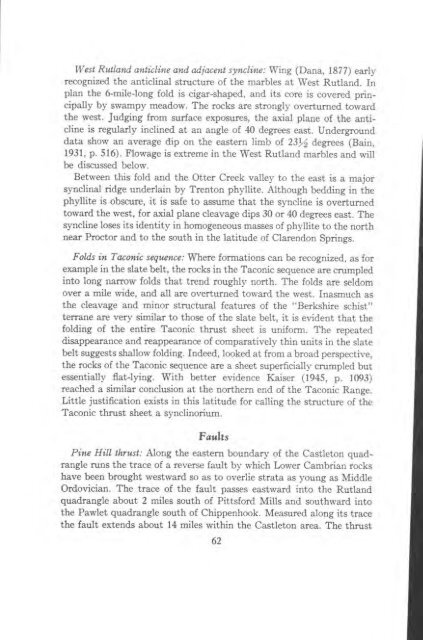STRATIGRAPHY AND STRUCTURE CASTLETON AREA VERMONT
STRATIGRAPHY AND STRUCTURE CASTLETON AREA VERMONT
STRATIGRAPHY AND STRUCTURE CASTLETON AREA VERMONT
Create successful ePaper yourself
Turn your PDF publications into a flip-book with our unique Google optimized e-Paper software.
West Rutland anticline and adjacent syncline: Wing (Dana, 1877) early<br />
recognized the anticlinal structure of the marbles at West Rutland. In<br />
plan the 6-mile-long fold is cigar-shaped, and its core is covered principally<br />
by swampy meadow. The rocks are strongly overturned toward<br />
the west. Judging from surface exposures, the axial plane of the antidine<br />
is regularly inclined at an angle of 40 degrees east. Underground<br />
data show an average dip on the eastern limb of 23Y2 degrees (Bain,<br />
1931, p. 516). Flowage is extreme in the West Rutland marbles and will<br />
be discussed below.<br />
Between this fold and the Otter Creek valley to the east is a major<br />
synclinal ridge underlain by Trenton phyllite. Although bedding in the<br />
phyllite is obscure, it is safe to assume that the syncline is overturned<br />
toward the west, for axial plane cleavage dips 30 or 40 degrees east. The<br />
syncline loses its identity in homogeneous masses of phyllite to the north<br />
near Proctor and to the south in the latitude of Clarendon Springs.<br />
Folds in Taconic sequence: Where formations can be recognized, as for<br />
example in the slate belt, the rocks in the Taconic sequence are crumpled<br />
into long narrow folds that trend roughly north. The folds are seldom<br />
over a mile wide, and all are overturned toward the west. Inasmuch as<br />
the cleavage and minor structural features of the "Berkshire schist"<br />
terrane are very similar to those of the slate belt, it is evident that the<br />
folding of the entire Taconic thrust sheet is uniform. The repeated<br />
disappearance and reappearance of comparatively thin units in the slate<br />
belt suggests shallow folding. Indeed, looked at from a broad perspective,<br />
the rocks of the Taconic sequence are a sheet superficially crumpled but<br />
essentially flat-lying. With better evidence Kaiser (1945, p. 1093)<br />
reached a similar conclusion at the northern end of the Taconic Range.<br />
Little justification exists in this latitude for calling the structure of the<br />
Taconic thrust sheet a synclinorium.<br />
Faults<br />
Pine Hill thrust: Along the eastern boundary of the Castleton quadrangle<br />
runs the trace of a reverse fault by which Lower Cambrian rocks<br />
have been brought westward so as to overlie strata as young as Middle<br />
Ordovician. The trace of the fault passes eastward into the Rutland<br />
quadrangle about 2 miles south of Pittsford Mills and southward into<br />
the Pawlet quadrangle south of Chippenhook. Measured along its trace<br />
the fault extends about 14 miles within the Castleton area. The thrust<br />
62













